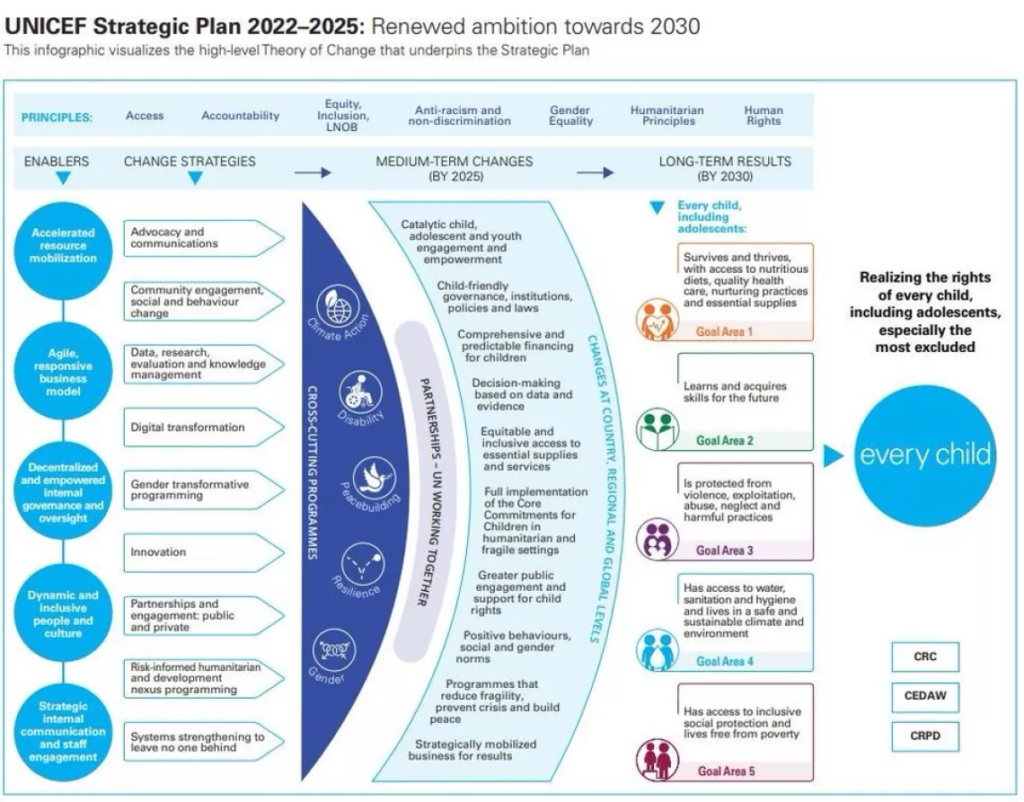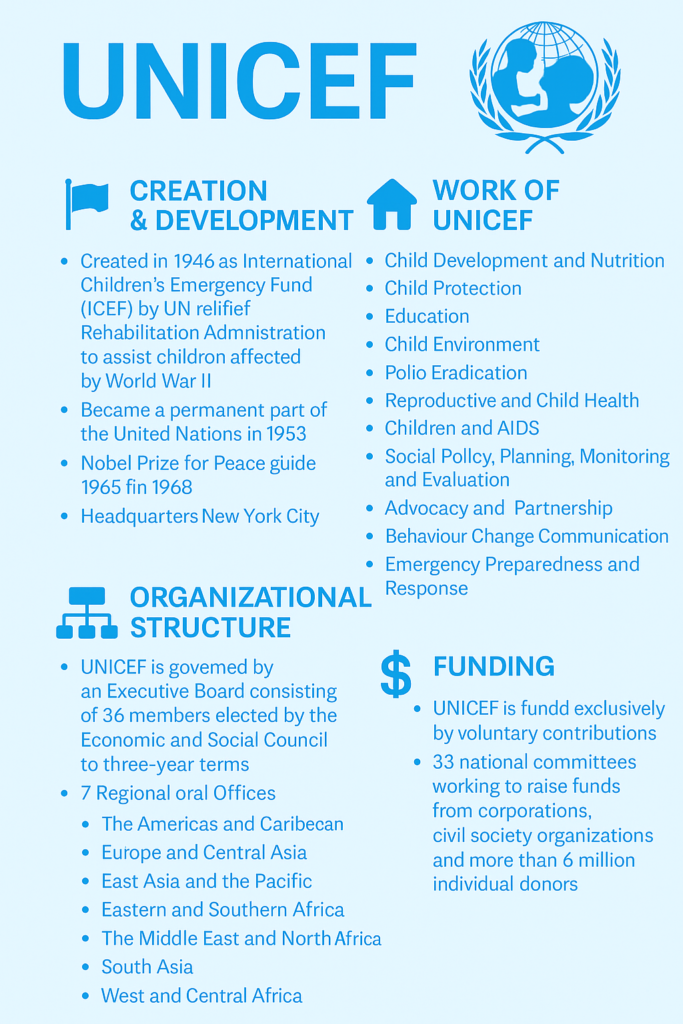
Introduction
The United Nations Children’s Fund (UNICEF) is one of the most prominent international organizations devoted to ensuring the welfare of children and women around the globe. Operating in over 190 countries and territories, UNICEF plays a vital role in improving health, nutrition, education, protection, and the overall development of children. With decades of service, UNICEF continues to be at the forefront of humanitarian and development work focused on the world’s most vulnerable populations.
History Behind the Creation of UNICEF
UNICEF was originally established in 1946 as the International Children’s Emergency Fund (ICEF) by the UN Relief Rehabilitation Administration. The primary aim was to provide urgent relief to millions of children affected by the devastating aftermath of World War II.
As global needs evolved, UNICEF shifted from emergency relief to long-term development work. In 1953, UNICEF was made a permanent part of the United Nations, and the name was officially changed to the United Nations Children’s Fund—though the acronym UNICEF was retained.
UNICEF is guided by the 1989 Convention on the Rights of the Child, advocating for the protection of children’s rights, ensuring their basic needs, and expanding opportunities to help every child reach their full potential. Its work is recognized globally, and in 1965, UNICEF was awarded the Nobel Peace Prize for promoting international brotherhood.
- Headquarters: New York City, USA
- Members: Over 190 countries and territories
Key Areas of UNICEF’s Work
Over the decades, UNICEF has evolved into a multi-dimensional organization addressing a wide range of child-related issues:
1. Child Development and Nutrition
Ensuring children have access to adequate food, nutrients, and health services to grow and thrive.
2. Child Protection
Safeguarding children from violence, exploitation, abuse, and neglect.
3. Education
Promoting inclusive, equitable, and quality education for every child, especially girls and marginalized groups.
4. Health Interventions
- Polio eradication
- Growth monitoring
- Immunization programs
- Promotion of breastfeeding
- Oral rehydration therapy
5. Reproductive and Child Health
Supporting maternal and child health programs, especially in developing nations.
6. Environment and Sanitation
Improving water, hygiene, and sanitation to create safe environments for children.
7. Emergency Preparedness and Response
Delivering life-saving aid during conflicts, natural disasters, and pandemics.
8. Social Policy and Monitoring
Collecting data, planning, and evaluating child-focused policies and advocating for social change.
9. Advocacy, Partnerships, and Communication
Engaging with media, civil society, governments, and individuals to promote child rights and behavior change.

Organisational Structure of UNICEF
UNICEF is governed by an Executive Board consisting of 36 members, elected by the UN Economic and Social Council (ECOSOC) for three-year terms. The Executive Board oversees policies, programs, and budgets.
Regional Offices:
- Panama City, Panama – The Americas and Caribbean
- Geneva, Switzerland – Europe and Central Asia
- Bangkok, Thailand – East Asia and the Pacific
- Nairobi, Kenya – Eastern and Southern Africa
- Amman, Jordan – Middle East and North Africa
- Kathmandu, Nepal – South Asia
- Dakar, Senegal – West and Central Africa
Additionally, 33 national committees, functioning as NGOs, support UNICEF’s global mandate by fundraising, advocacy, and public outreach.
Funding UNICEF: A Global Effort
UNICEF is funded entirely by voluntary contributions, receiving support from:
- Governments
- Private sector
- Civil society organizations
- Over 6 million individual donors
The National Committees play a crucial role by raising approximately one-third of UNICEF’s total annual income. These committees also amplify global awareness and advocacy for children facing poverty, abuse, violence, and conflict.
UNICEF collaborates with diverse stakeholders including:
- Media
- NGOs
- Medical professionals
- Lawyers
- Corporations
- Schools
- Young people

UNICEF in India: A Strong and Impactful Partnership
UNICEF’s journey in India began in 1949, and by 1952, it had established its office in New Delhi. Today, UNICEF is active in 16 states, working in close coordination with the Ministry of Women and Child Development (MWCD).
Major Initiatives and Achievements in India:
1. 2011 Census Support
Mainstreamed gender sensitivity into the training of 2.7 million census workers to gather accurate, disaggregated data.
2. Polio Campaign (2012)
UNICEF played a pivotal role in India’s battle against polio. From 559 cases in 2008 to zero in 2012, India’s success was a collaborative effort involving:
- WHO
- CDC
- Bill & Melinda Gates Foundation
- Rotary International
India was declared polio-free in 2014.
3. Maternal and Child Health
Through support to NHM and the RCH-II programme, India saw a decline in:
- Maternal Mortality Rate (MMR): 130 per 100,000 live births (2014-16)
- Infant Mortality Rate (IMR): 34 per 1,000 live births (2016)
4. Call to Action (2013)
A collective initiative to reduce under-five mortality involving government, NGOs, and development partners.
5. Maternal and Child Nutrition Campaign (2013)
One of India’s largest public service campaigns, reaching millions through 18 languages and diverse media channels.
6. India Newborn Action Plan (2014)
A region-first initiative to improve newborn health under the broader RMNCH+A framework.
Government Key Child Development Schemes
UNICEF supports and strengthens existing government programs to scale impact and improve delivery.
1. POSHAN Abhiyaan (National Nutrition Mission)
- Launched: 2018
- Objective: Improve nutritional outcomes for children, pregnant women, and lactating mothers.
- UNICEF Role:
- Technical support in planning and monitoring.
- Social behaviour change communication (SBCC).
- Data analysis through Jan Andolan (People’s Movement).
2. Integrated Child Development Services (ICDS)
- Launched: 1975
- Objective: Provide food, preschool education, and primary healthcare to children under 6.
- UNICEF Role:
- Capacity building of Anganwadi workers.
- Improving data monitoring systems.
- Supporting early childhood education and nutrition strategies.
3. National Health Mission (NHM)
- Components: Reproductive, Maternal, Newborn, Child, and Adolescent Health (RMNCH+A)
- UNICEF Role:
- Strengthening immunization and newborn care.
- Promoting institutional deliveries (JSY/JSSK).
- Health system strengthening.
4. Sarva Shiksha Abhiyan (SSA) / Samagra Shiksha
- Objective: Universal elementary education.
- UNICEF Role:
- Inclusion of out-of-school children.
- Promoting gender-sensitive and inclusive classrooms.
- Teacher training and curriculum development.
5. Beti Bachao Beti Padhao (BBBP)
- Launched: 2015
- Objective: Address declining Child Sex Ratio and promote girl child education.
- UNICEF Role:
- Advocacy and awareness campaigns.
- Mobilizing communities for gender equality.
6. Rashtriya Kishor Swasthya Karyakram (RKSK)
- Target Group: Adolescents (10–19 years)
- UNICEF Role:
- Life skills education.
- Adolescent-friendly health services.
- Menstrual hygiene management (MHM) initiatives.
7. Right to Education (RTE) Act Implementation
- UNICEF Support:
- Ensuring equitable access to quality education.
- Promoting inclusive education for children with disabilities.
Impact of UNICEF-Government Partnership
| Focus Area | Key Outcomes |
|---|---|
| Nutrition | Drop in child stunting and wasting rates |
| Education | Increased school enrollment and attendance |
| Child Protection | Better reporting of child abuse and trafficking |
| WASH | Improved access to safe water and sanitation |
| Health | Higher immunization coverage |
Key UNICEF Initiatives Complementing Govt Schemes
- U-WIN Platform: For real-time immunization tracking.
- Jan Andolan Campaigns: Community-based nutrition awareness.
- Childline (1098): 24×7 helpline for children in distress.
- Social Protection Programs: Integration of children in social safety nets.
UNICEF Strategic Plan (2022–2025)
The Strategic Plan 2022–2025 is designed as UNICEF’s roadmap for rebuilding a post-pandemic world where all children can thrive. It aligns with the 2030 Agenda for Sustainable Development and emphasizes:
- Inclusive recovery from COVID-19
- Accelerating SDG achievement
- Fulfilling children’s rights without discrimination
- Strengthening climate action, mental health care, and social protection
This plan is informed by insights from children, communities, governments, civil society, and global partners. It sets the direction for national programs and regional actions that ensure a more just, equitable, and child-friendly world.
Conclusion
UNICEF continues to be a cornerstone of global efforts to protect and promote the rights of children. From emergency relief to long-term development initiatives, UNICEF’s reach and impact are profound. Its collaborative approach—engaging governments, communities, civil society















